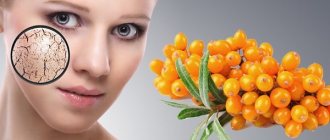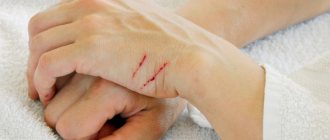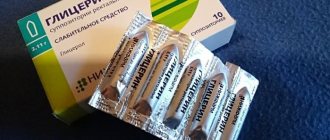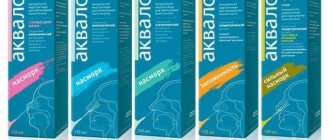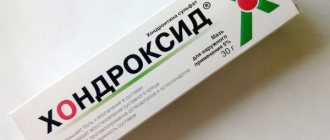Release form and composition
Dosage form – solution for local and external use: colorless, transparent, odorless (40 or 100 ml in a bottle, 1 bottle in a cardboard box).
Composition of 100 ml solution:
- active substance: medical hydrogen peroxide – 7.5–11 g [depending on the actual content of hydrogen peroxide in the original substance is equivalent to the content of hydrogen peroxide – 3 g (from 30 to 40%)];
- auxiliary components: sodium benzoate, purified water.
General information
Do not confuse hydrogen peroxide solution with regular hydrogen peroxide, which can be harmful. 3% hydrogen peroxide should never be taken. Can be diluted in water.
Many sources talk about the benefits and positive aspects after taking it, while keeping silent about possible risks and dangers.
Hydrogen peroxide exists in 2 forms - liquid and tablet form.
- Perhydrol (3% peroxide in liquid form);
- Hydroperite (35% peroxide in tablet form).
1 tablet contains 1 tbsp. l. liquid solution.
Due to its liquid form, perhydryl is widespread and easy to use in medicine. Hydroperite is usually used independently at home.
Pharmacological properties
Pharmacodynamics
Hydrogen peroxide is an antiseptic and belongs to the group of antioxidants. The effect of the drug is due to the release of active oxygen at the moment of its contact with damaged areas of the skin or mucous membrane, which leads to softening and separation of necrotic tissue areas, as well as clots of pus and blood. It does not have a sterilizing effect; the decrease in the number of microorganisms under its influence is temporary. In addition, abundant foaming leads to stopping bleeding from small vessels.
Methods of application
When treating, there are 3 options for using the solution.
External method
This method is used to treat ulcers and wounds. You need to mix water and peroxide 3 tbsp. l. and apply lotions to the affected area for 40-60 minutes.
Often the solution is added to the bath. You need to stay in such a bath for no longer than 20 minutes. To enhance the results, immediately after the bath you should take a quick, refreshing shower. Such baths are effective for skin problems, joint and stomach diseases.
Effective for tooth pain. To do this, you need to dissolve 2 tablets in 150 ml of liquid and rinse the mouth for 2-3 minutes.
Hydrogen peroxide helps whiten teeth, which is why it is found in many oral cleansers.
You can gargle with the solution during a sore throat. It kills bacteria and is able to penetrate into the most remote areas of the oral cavity.
Internal method
Hydrogen peroxide is diluted with a certain amount of water. This option is not recognized by doctors, but representatives of folk remedies often resort to this method in the treatment of serious pathologies.
When taken orally, the peroxide solution achieves the following results:
- beneficial effect on the functioning of the stomach and intestines. The acid-base balance is stabilized, stomach ulcers heal;
- blood circulation is saturated. Perhydrol, once inside, quickly spreads throughout the body, saturating the cells with oxygen, as a result of which the symptoms of oxygen starvation disappear;
- the immune system is strengthened;
- Toxic substances are removed from the body, rapid heartbeat and nausea disappear;
- promotes weight loss. If you take a peroxide solution in the morning on an empty stomach, your metabolism will normalize, which will help you lose weight. 20-30 minutes before meals you need to take 2-4 drops of a solution diluted in ¼ cup once a day. This procedure should be repeated no more than 3 times a week.
Intravenous method
There is a lot of controversy surrounding this method among scientists who prove the pros and cons of its use. Intravenous administration of the solution is considered the most dangerous. But if everything is done correctly, you can achieve an excellent result and the patient will feel much better.
The use of hydrogen peroxide in cosmetology
The properties of the beneficial solution are used not only for disinfection and general improvement of the body. The substance is beneficial in home cosmetology and is part of many simple but effective products.
- The healing properties of hydrogen peroxide for the face are widely known - the solution is an excellent antiseptic. It is especially beneficial for oily skin prone to acne - problem areas should be regularly wiped with a cotton pad soaked in the solution. It is not recommended to apply the product all over the face; it can harm healthy areas of the skin.
- Since the useful solution has whitening properties, it can be used to even out the complexion. Before washing, it must be diluted with water to avoid burning the skin, and you should not keep the product on your face for too long.
- Hydrogen peroxide is a proven home remedy for lightening hair. Using a diluted solution, you can carry out effective home blondening, as well as lighten unwanted hairs above the upper lip.
Since even a diluted substance can be harmful with constant use, it is recommended to use it on the face no more than a couple of times a week.
Hydrogen peroxide - solution for local and external use
Home \ Medicines \ Solutions for external use \ Hydrogen peroxide 3% and 6%
Trade name: Hydrogen peroxide INN or group name: Hydrogen peroxide Dosage form: Solution for local and external use Composition: Active substance: Medical hydrogen peroxide - from 7.5 to 11 g depending on the actual content of hydrogen peroxide in the original substance is equivalent to the content of hydrogen peroxide – 3 g (from 30 to 40%) Excipients: Sodium benzoate – 0.05 g; purified water - up to 100 ml. Conditions for dispensing from pharmacies: without a prescription. Description: Colorless, transparent, odorless liquid. Pharmacotherapeutic group: Antiseptic.
| Name | Quantity, pcs. in pack | Price in rub. | Manufacturer |
| Hydrogen peroxide solution for local and external use 3%, 1 l - polymer canisters | 1 | 49,16 | RusbioAgroFarm, Russia |
| Hydrogen peroxide solution for local and external use 6%, 1 l - polymer canisters | 1 | 123,00 | RusbioAgroFarm, Russia |
| Hydrogen peroxide solution for local and external use 6%, 10 l - polymer canisters | 1 | 830,00 | RusbioAgroFarm, Russia |
| Hydrogen peroxide solution for local and external use 6%, 5 l - polymer canisters | 1 | 495,00 | RusbioAgroFarm, Russia |
| Hydrogen peroxide, solution for local and external use 3% - 100 ml bottle | 1 | 34,50 | Ecotex, Russia |
Pharmacological properties: Antiseptic from the group of antioxidants. When hydrogen peroxide comes into contact with damaged skin or mucous membranes, active oxygen is released, and mechanical cleansing and inactivation of organic substances (proteins, blood, pus) occurs. The antiseptic effect is not sterilizing; when used, only a temporary decrease in the number of microorganisms occurs. Abundant foaming promotes thrombus formation and stops bleeding from small vessels.
Indications for use:
Inflammatory diseases of the mucous membranes, purulent wounds, capillary bleeding from superficial wounds, nosebleeds.
For disinfection and deodorization: stomatitis, sore throat, tonsillitis, gynecological diseases.
Contraindications: Hypersensitivity to the components of the drug.
With caution: Decompensated liver and kidney diseases, hyperthyroidism, dermatitis herpetiformis.
Use during pregnancy and lactation: The drug has no contraindications for use during pregnancy and lactation.
Directions for use and dosage:
For external use, use a 1-3% solution; for rinsing the mouth and throat, applying to mucous membranes - a 0.25% solution (3% solution is diluted with water in a ratio of 1:11).
Damaged areas of the skin or mucous membrane are treated with a cotton or gauze swab moistened with a solution of the drug. Tampons should be held with tweezers. Jet irrigation of the wound surface is possible.
Side effects: burning sensation during wound treatment, allergic reactions.
Overdose:
Symptoms: irritation of the upper respiratory tract (burn, laryngo-bronchospasm); if ingested - irritation of the mucous membranes of the gastrointestinal tract, hemolysis, hemoglobinuria; lethal dose – about 3 g.
Treatment: gastric lavage with 0.5% sodium thiosulfate solution, sodium bicarbonate solutions, intravenous sodium thiosulfate 30% - up to 300 ml.
Special instructions:
It is not recommended to use the drug under occlusive dressings. Avoid contact with eyes! Do not use for irrigation of cavities! Treatment of a wound with a solution of hydrogen peroxide does not guarantee against infection with tetanus and other wound infections. A 3% solution is used orally in toxicological practice as an antidote (in combination with a 3% acetic acid solution) for potassium permanganate poisoning. Interaction with other drugs and other forms of interaction: Hydrogen peroxide solution is unstable in an alkaline environment, in the presence of metal salts, complex radicals of some oxidants, as well as in light and heat. Effect on the ability to drive vehicles and machinery: No effect. Release form: Solution for local and external use 3%. 40, 100 ml in glass bottles or glass dropper bottles with a screw neck, sealed with polyethylene stoppers and screw caps or caps with gaskets. 40 ml, 100 ml in bottles for medicines made of high or low pressure polyethylene, sealed with screw-on plastic caps with gaskets or with a special nozzle. Each bottle, dropper bottle, along with instructions for use, is placed in a cardboard pack. It is allowed to pack glass bottles of 40 ml and 100 ml, together with an equal number of instructions for use, in a cardboard box with partitions or grids made of corrugated cardboard. It is allowed to pack polyethylene bottles of 40 ml and 100 ml, along with an equal number of instructions, in polyethylene shrink film or cardboard boxes. 500 ml, 1000 ml in bottles, sealed with screw-on plastic caps with gaskets (for hospital use). 12 bottles of 500 ml each, 8 bottles of 1000 ml each, together with an equal number of instructions for use, are packaged in polyethylene shrink film or in corrugated cardboard boxes (for hospitals). Shelf life: 2 years. Do not use the drug after the expiration date indicated on the package. Storage conditions: In a place protected from light at a temperature not exceeding 25 C. Keep out of the reach of children. Indication, if necessary, of special precautions when destroying unused drug: When destroying unused drug, no special precautions are required. Trade name: Hydrogen peroxide INN: Hydrogen peroxide Chemical name Hydrogen peroxide Dosage form Solution for local and external use Composition: Hydrogen peroxide - from 7.5 to 11 g, depending on the actual content of hydrogen peroxide in the original preparation Sodium benzoate - 0.05 g Water purified to 100 ml.
Description: Colorless, transparent, odorless liquid. Pharmacotherapeutic group: Antiseptic. Pharmacological action: Antiseptic from the group of oxidants. When hydrogen peroxide comes into contact with damaged skin or mucous membranes, active oxygen is released, and mechanical cleansing and inactivation of organic substances (proteins, blood, pus) occurs. The antiseptic effect is not sterilizing; when used, a temporary decrease in the number of microorganisms occurs. Abundant foaming promotes thrombus formation and stops bleeding from small vessels.
Indications for use: Inflammatory diseases of the mucous membranes, purulent wounds, capillary bleeding from superficial wounds, nosebleeds. For disinfection and deodorization: stomatitis, tonsillitis, gynecological diseases. Contraindications Hypersensitivity. Directions for use and dosage: Apply externally in the form of a 1-3% solution. Damaged areas of the skin or mucous membranes are treated with a cotton or gauze swab moistened with a solution - 2 - of the drug or irrigated with a stream. Tampons should be held with tweezers! A 0.25% solution is applied to the mucous membranes. Side effects: Burning sensation during wound treatment, allergic reactions. Special instructions It is not recommended to use the drug under occlusive dressings. Avoid contact with eyes! Do not use for irrigation of cavities! Unstable in an alkaline environment, in the presence of metal alkalis, complex radicals of some oxidants, as well as in light and heat. Treating a wound with a 3% hydrogen peroxide solution does not guarantee against infection with tetanus and other wound infections. Release form: Solution for local and external use, 100 ml in an orange glass bottle or jar; 30 ml, 50 ml, 70 ml and 100 ml in a polymer bottle. Storage conditions In a place protected from light at a temperature of 10 to 20 0 C. Out of reach of children. Shelf life: 2 years. Do not use after the expiration date indicated on the package. Conditions for dispensing from pharmacies: Without a prescription. Instructions for use Hydrogen peroxide 6% Hydrogen peroxide 6% is a colorless, transparent, odorless liquid containing 6% hydrogen peroxide (HP) as an active ingredient. The product is packaged:
- glass bottles with a capacity of 100 ml, 200 ml and 400 ml;
- polymer bottles with a capacity of 100 ml;
- bottles or bottles made of polyethylene with a capacity of 500 ml, 1.0 l;
- polyethylene canisters with a capacity of 2.0 l, 3.0 l, 5.0 l and 10.0 l.
The shelf life of the product in unopened manufacturer's packaging, if stored in a dark place at a temperature of no more than 250C, is 2 years, the shelf life in opened packaging is 12 months from the date of opening the package within the expiration date; Shelf life of working solutions is 48 hours. Purpose: intended for processing: underwear, bed linen, hard furniture, toys, medical devices made of metals, rubbers based on natural and silicone rubber, glass, plastics, conventional medical devices, dental instruments, surgical instruments, indoor surfaces, surfaces of devices and apparatus , patient care items, sanitary equipment, ambulance transport, tableware, dental materials (impressions made of alginate, silicone, polyester resin, denture blanks, articulators), cleaning equipment. Ingredients: hydrogen peroxide 6%, auxiliary components. Properties: active against: bacteria - Mycobacterium terrae, gram-negative bacteria, gram-positive bacteria; viruses - adenoviruses, HIV, herpes, influenza, coxsackie, ECHO, parenteral hepatitis, polio, other pathogens of ARVI, avian influenza (H5N1), rotaviruses, swine influenza (H1N1), enteral hepatitis; pathogens of particularly dangerous infections - melioidosis, glanders, anthrax, tularemia, cholera, plague; pathogenic fungi - dermatophyton. Application: Disinfection of surfaces for bacteria (excluding tuberculosis) - 3% / 90 min. Disinfection of surfaces for viral infections - 4% / 90 min. Disinfection of surfaces for dermatophytes - 4% / 90 min. Disinfection of surfaces for tuberculosis - 5% / 60 min. 6% / 30 min. Disinfection of medical devices for bacterial, viral infections and candidiasis - 3% / 180 min. 4% / 90 min. 6% / 60 min. Pre-sterilization cleaning of medical devices - 0.5% / 15 min.
Storage and shelf life
The instructions for use recommend storing hydrogen peroxide in a cool place (not higher than 15 ºС), protected from children and light. During storage, a sediment may form, which disappears when the bottle is vigorously shaken, but it does not affect the quality of the drug and cannot be the reason for its unsuitability. It is not recommended to use peroxide after the expiration date.
These instructions are provided for informational purposes only, and before starting self-treatment, it is important to consult a doctor. There is a huge amount of information and recipes on the Internet, but only a specialist can prescribe the correct treatment regimen, so you should not risk your health. In addition to treatment, hydrogen peroxide is also used for teeth whitening. As a rule, the process is the usual rubbing with a cotton ball soaked in peroxide, or mixing with toothpaste. However, it should be remembered that the active substance of the whitening product can destroy tooth enamel, so here, too, you cannot do without the advice of a dentist. Be healthy and consult your doctors!
How to use hydrogen peroxide at home
The whitening and antiseptic properties of the solution make it very popular in household use. Using hydrogen peroxide you can:
- clean furniture, plastic surfaces, plumbing fixtures and pipes from plaque and old grease; the product will not only remove dirt, but also eliminate bacteria and unpleasant odors;
- bleach things when washing, if before washing you hold white things in a basin with peroxide diluted in it for a little while, then the clothes will return to their original color, and yellow sweat stains will disappear;
- eliminate fungus and mold in the kitchen or bathroom - to do this, mix the solution and water in a ratio of 1 to 2 and apply to the infected surface for 10 minutes.
Hydrogen peroxide can be added to water for cleaning floors. It is especially useful to do this if there is a small child in the house, and it is necessary to keep the apartment as clean as possible.
Neumyvakin scheme
Attention! World and domestic official medicine does not recognize such practices and considers them dangerous to health. We strongly do not recommend experimenting with your own health. Always use only proven and scientifically proven treatment methods.
Hydrogen peroxide is actively used in clinical practice not only by conservative, but also by alternative, “folk” medicine. If in the context of external use, the methods of these two diametrically opposed practical areas of social life practically coincide, then debates about the possibility of systemic internal use of the drug do not subside to this day.
From the point of view of traditional medicine, any use of hydrogen peroxide other than topical entails a huge risk to the health and life of the patient - this drug is a reactive form of oxygen, which, when directly exposed to unprotected cells, causes their oxidative damage. At the same time, supporters of non-traditional forms of treatment have a significant argument in this matter - the scientific works of Ivan Pavlovich Neumyvakin, Doctor of Medical Sciences, a professor who has been closely involved in the problems of space medicine for almost 3 decades and actually stood at its origins. A versatile scientist and physician, in addition to his direct duties, he develops his own alternative treatment regimens. One of them is based on the internal use of hydrogen peroxide for the treatment of a number of diseases.
There are two basic schemes for using hydrogen peroxide according to the Neumyvakin system. They include oral administration of the drug, as well as its intravenous administration.
According to Neumyvakin, with the help of hydrogen peroxide, myocardial infarction, gastrointestinal diseases, diabetes mellitus, osteochondrosis, bronchopulmonary pathologies and other diseases, including cancerous tumors, can be effectively treated. Moreover, the professor is not only a theorist and the author of more than six dozen books - as part of supporting the methods of alternative medicine, he operates his own health center named after Neumyvakin, which is visited by over 2 thousand people annually, and experimental treatment is also carried out there based on the schemes and postulates of the traditional healer.
Is it worth trying the above procedures on yourself?
Which is better: Hydrogen peroxide or Chlorhexidine
Chlorhexidine.
Photo: insales.ru The drugs are not analogues of each other. They are classified as antiseptics. Hydrogen Peroxide's antiseptic effect is not sterilizing. Additionally, it has a hemostatic effect. Chlorhexidine has a more pronounced antiseptic effect than hydrogen peroxide. Release form: solution for external and local use. The drug Chlorhexidine is additionally available in the form of vaginal suppositories. Both drugs are over-the-counter.
Chlorhexidine is cheaper in cost than Hydrogen Peroxide. Price for one bottle from 8 rubles.
Reviews
Ivan. Peroxide helped me stop heavy bleeding. To do this, I rolled two tubes from a gauze bandage, soaked them in it and placed them in the nose. The bleeding stopped very quickly. Therefore, now I always keep a bottle of this liquid in my first aid kit.
Olga. And I use this healing liquid to whiten my teeth. To do this, I dilute the peroxide in water and rinse my mouth with it. Teeth are not only cleaned of plaque, but also become strong and beautiful. In addition, the gums are strengthened.
Contraindications and overdose
Taking hydrogen peroxide orally is prohibited under the following conditions:
- diabetes;
- ulcer or gastritis;
- pancreatitis;
- during transplantation;
- period of bearing a child;
- lactation period;
- children and teenagers.
Some people, without thinking about the possible consequences, take the solution in unlimited quantities.
In case of overdose, the following conditions and reactions of the body may be observed:
- burn of the mucous membrane of the intestines and stomach;
- blockage of blood vessels;
- vomiting and nausea;
- internal hemorrhage;
- general poisoning;
- allergic reaction in the form of skin rashes or runny nose;
- drowsiness and lethargy;
- burning sensation in the stomach area.
Analogs
Other drugs intended for antiseptic treatment are considered as analogues of the product.
Miramistin
Miramistin is a popular composition produced in several dosage forms. The product ensures complete disinfection of the skin surface and is active against many pathogens. The composition enhances the activity of local antibiotics. Suitable for long term use.
Iodinol
The drug Iodinol has a wide range of indications for use. The composition is suitable only for local application to the skin. The product contains iodine, so its use is contraindicated in patients with thyroid diseases.
Contraindications to the use of hydrogen peroxide
For some diseases, it is not recommended to take the solution orally at all; it can cause harm even in dosages that are safe for healthy people. Contraindications include:
- diabetes;
- acute gastritis or stomach ulcer;
- pancreatitis and other diseases of the pancreas;
- atherosclerosis;
- intolerance to the drug.
The use of the solution is prohibited in the presence of transplanted organs. Pregnant women and nursing mothers should avoid internal use of the product. It is strictly forbidden to offer peroxide for oral use to children and adolescents - it will only cause harm; it is necessary to limit it to external methods of use.
Biological and medicinal properties
Hydrogen peroxide in its standard form is a colorless and odorless liquid. It has a metallic taste, easily dissolves in ethers, alcohols, water and other liquids. The molecular structure of the product is polar; upon self-decomposition, it releases an unstable form of a typical crystalline hydrate.
Peroxide can oxidize nitrates and nitrites, cleave double bonds of unsaturated compounds, and reduce salts of a number of metals, manganese, and iodine in acidic environments. Due to the fact that the drug is a reactive form of oxygen, its presence in cells causes their oxidative stress. However, in the body, peroxide can act as a bactericidal agent - some enzymes form it during complex redox reactions.
Since hydrogen peroxide is used in clinical practice only externally, the pharmacokinetics of peroxide have not been studied. The pharmacodynamics of the drug includes the mechanisms of antiseptic and thrombus-forming effects on the external integument. Thus, upon contact with tissue, active oxygen is released from the product, which mechanically cleanses and inactivates organic matter - blood, exudate, proteins, while providing temporary (but not sterile) antiseptics of the treated surface. Extremely abundant foaming after contact with skin and mucous membranes also causes thrombus formation, with a slight hemostatic effect (at the level of slight damage to peripheral vessels).
Pharmacological group
Antiseptic solution intended for topical use.
The composition is a product that has a pronounced bactericidal effect against gram-positive and gram-negative bacteria. The composition is also effective against aerobic and anaerobic monocultures, hospital strains that have individual activity against antibiotics. This medicine also has an antifungal effect and perfectly destroys yeast and yeast-like fungi. The drug also destroys types that are resistant to chemotherapy drugs.
The pharmacological agent can be used to destroy complex viruses. Under the influence of such a composition, the likelihood of infection of burns and wound lesions is reduced. Regeneration processes are accelerated. The drug has a pronounced osmotic activity and stops wound inflammation, ensures the absorption of purulent exudate, and the formation of dry exudate from the corpse.
A significant advantage is that the drug does not penetrate the systemic bloodstream and does not provoke the appearance of allergic reactions. The composition is well tolerated by patients of various groups.
Use in folk medicine
Treatment with hydrogen peroxide is widespread in folk medicine. Some “specialists” of such treatment (W. Douglas, C. Farr (USA), Prof. I.P. Neumyvakin) believe that any disease can be overcome with this drug. Moreover, there are no side effects of this treatment.
IMPORTANT: Any treatment is possible only with the help of a certified specialist. You should not self-medicate, especially on the basis of unproven facts. Below are the most “harmless” recipes using the described drug.
- Fungal infection and warts. Lotions based on a 6%-15% hydrogen peroxide solution are used. Course of treatment: 8-10 procedures
- Arthritis and joint pain. Compresses based on a 0.5%–1% solution. Keep on the sore spot for no more than 2 hours. Course of treatment: until pain decreases
- For ear diseases. Mix one teaspoon of water with 1 drop of 3% hydrogen peroxide. The solution is instilled into the ears (2 drops each). Course of treatment: 30 days
- Lightening hair on arms. You need to mix water (30 ml) and hydrogen peroxide in equal proportions. Then you need to add ammonia (10 ml) and ½ teaspoon of soda to the resulting solution. The composition should be applied to the skin of the hand and left for one hour. After which the skin should be washed thoroughly
IMPORTANT: You can use this solution only after making sure that it will not be harmful to your skin. Place a couple of drops of the solution on the crook of your elbow. If the skin does not turn red or itch, then it can be used.
- Baths with a spa effect. To eliminate metabolic products excreted through the skin, you can use baths with the described drug. Such baths not only have a spa effect, but will also help cleanse the skin of various fungi. You can use no more than 200-250 ml of 3% hydrogen peroxide per bath. It needs to be diluted in warm water (37 degrees). You can take such a bath for no longer than 30 minutes. After which you need to take a warm shower
Applications and dosages
The dosage regimen is determined individually depending on the goals of therapeutic action. Hydrogen peroxide is for skin use only. Oral consumption, as well as injection administration, is unacceptable.
The scheme of use involves applying the solution directly to the lesion. The product is used to treat burns, cuts and injuries several times a day. After applying the composition at the site of damage, a reaction is observed that indicates the rapid destruction of pathogens.
for adults
Persons in this age category use the composition locally on the affected area several times a day. When using for the first time, you need to refute the possibility of adverse reactions.
for children
The composition is actively used in pediatric practice as prescribed by a doctor. The product is applied to the skin several times a day.
for pregnant women and during lactation
Hydrogen peroxide can be used during pregnancy and breastfeeding if indications for use are identified. The composition is well tolerated, the likelihood of hypersensitivity reactions is minimized.
How to drink hydrogen peroxide for weight loss
When used carefully, the properties of the solution will help you lose excess weight. The benefit of hydrogen peroxide in the morning on an empty stomach is that the solution speeds up metabolism and removes toxins and toxic substances. Therefore, digestion begins to work better, and fat deposits are rapidly reduced.
For weight loss, you can take no more than 4 drops of the solution per day; before use, they must be diluted in 1/4 glass of water. You should drink the solution shortly before eating, or a couple of hours after breakfast.

